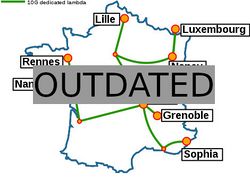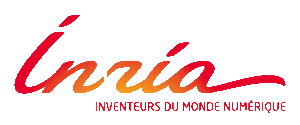Grid5000:Home: Difference between revisions
No edit summary |
No edit summary |
||
| (5 intermediate revisions by 2 users not shown) | |||
| Line 4: | Line 4: | ||
|bgcolor="#f5fff5" style="border:1px solid #cccccc;padding:1em;padding-top:0.5em;"| | |bgcolor="#f5fff5" style="border:1px solid #cccccc;padding:1em;padding-top:0.5em;"| | ||
[[Image:renater5-g5k.jpg|thumbnail|250px|right|Grid'5000]] | [[Image:renater5-g5k.jpg|thumbnail|250px|right|Grid'5000]] | ||
'''Grid'5000 is a large-scale and | '''Grid'5000 is a large-scale and flexible testbed for experiment-driven research in all areas of computer science, with a focus on parallel and distributed computing including Cloud, HPC and Big Data and AI.''' | ||
Key features: | Key features: | ||
* provides '''access to a large amount of resources''': | * provides '''access to a large amount of resources''': 15000 cores, 800 compute-nodes grouped in homogeneous clusters, and featuring various technologies: PMEM, GPU, SSD, NVMe, 10G and 25G Ethernet, Infiniband, Omni-Path | ||
* '''highly reconfigurable and controllable''': researchers can experiment with a fully customized software stack thanks to bare-metal deployment features, and can isolate their experiment at the networking layer | * '''highly reconfigurable and controllable''': researchers can experiment with a fully customized software stack thanks to bare-metal deployment features, and can isolate their experiment at the networking layer | ||
* '''advanced monitoring and measurement features for traces collection of networking and power consumption''', providing a deep understanding of experiments | * '''advanced monitoring and measurement features for traces collection of networking and power consumption''', providing a deep understanding of experiments | ||
| Line 24: | Line 24: | ||
Older documents: | Older documents: | ||
* https://www.grid5000.fr/slides/2014-09-24-Cluster2014-KeynoteFD-v2.pdf Slides from Frederic Desprez's keynote at IEEE CLUSTER 2014 | * [https://www.grid5000.fr/slides/2014-09-24-Cluster2014-KeynoteFD-v2.pdf Slides from Frederic Desprez's keynote at IEEE CLUSTER 2014] | ||
* [https://www.grid5000.fr/ScientificCommittee/SAB%20report%20final%20short.pdf Report from the Grid'5000 Science Advisory Board (2014)] | * [https://www.grid5000.fr/ScientificCommittee/SAB%20report%20final%20short.pdf Report from the Grid'5000 Science Advisory Board (2014)] | ||
Revision as of 00:57, 12 February 2020
|
Grid'5000 is a large-scale and flexible testbed for experiment-driven research in all areas of computer science, with a focus on parallel and distributed computing including Cloud, HPC and Big Data and AI. Key features:
Grid'5000 is merging with FIT to build the SILECS Infrastructure for Large-scale Experimental Computer Science. Read an Introduction to SILECS (April 2018)
Older documents:
|
Random pick of publications
Five random publications that benefited from Grid'5000 (at least 2517 overall):
- Jose Jurandir Alves Esteves, Amina Boubendir, Fabrice Guillemin, Pierre Sens. On the Robustness of Controlled Deep Reinforcement Learning for Slice Placement. Journal of Network and Systems Management, 2022, 30 (3), pp.43. 10.1007/s10922-022-09654-8. hal-03954527 view on HAL pdf
- Quentin Guilloteau, Olivier Richard, Éric Rutten. Étude des applications Bag-of-Tasks du méso-centre Gricad. 2022. hal-03726257 view on HAL pdf
- Ilhem Fajjari, Wassim Aroui, Joaquim Soares, Vania Marangozova. Use Cases Requirements. UGA (Université Grenoble Alpes). 2024. hal-04450028 view on HAL pdf
- Tulika Bose, Nikolaos Aletras, Irina Illina, Dominique Fohr. Domain Classification-based Source-specific Term Penalization for Domain Adaptation in Hate-speech Detection. COLING 2022 - Proceedings of the 29th International Conference on Computational Linguistics, Oct 2022, Gyeongju, South Korea. hal-03815708 view on HAL pdf
- Leo Cazenille, Nicolas Bredeche, José Halloy. Automated optimization of multilevel models of collective behaviour: application to mixed society of animals and robots. Bioinspiration and Biomimetics, 2022, 17 (5), pp.055002. 10.1088/1748-3190/ac7fd1. hal-03842222 view on HAL pdf
Latest news
Failed to load RSS feed from https://www.grid5000.fr/mediawiki/index.php?title=News&action=feed&feed=atom: Error parsing XML for RSS
Grid'5000 sites
Current funding
As from June 2008, Inria is the main contributor to Grid'5000 funding.
INRIA |
CNRS |
UniversitiesUniversité Grenoble Alpes, Grenoble INP |
Regional councilsAquitaine |


